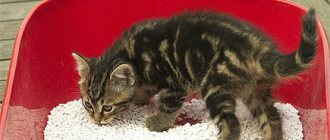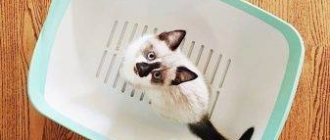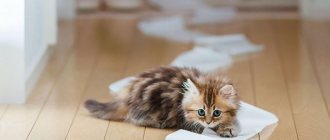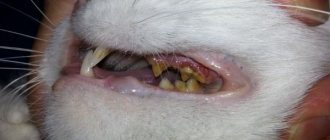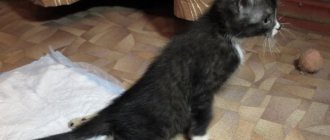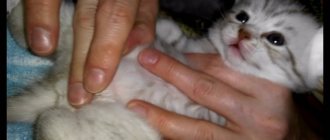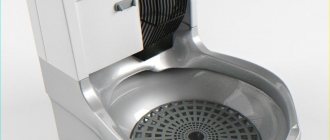How often does a cat go to the toilet: urination
Normally, the animal’s body should produce from 50 ml to 200 ml of urine, depending on the age of the pet.
The owner needs to know how often the cat should go to the toilet
Kittens have a small bladder capacity; they need to empty it up to 10 times a day, which is the norm. As the animal grows up, it needs the tray less and visits it 4-5 times a day.
Cats need to go to the toilet more often than cats, which is due to their physiology. With proper nutrition, cats pee up to 5 times a day, regardless of whether they are neutered or not. Cats urinate 3-4 times.
When urination becomes too frequent, a medical condition is not always present. Frequent visits to the litter box will be the norm for cats during pregnancy, as well as in the heat, when the animal drinks a large volume of water. In other cases, if you urinate too frequently, you should immediately contact a veterinarian.
Important! When an animal visits the litter box less than 2 times a day, it definitely needs veterinary care, since the condition indicates the development of pathology.
The cat goes to the toilet often. The cat frequently goes to the toilet. The kitten goes to the toilet often
Caring owners are alarmed when their cat walks frequently
into the tray. It is important to establish the cause in time. Frequent trips to the toilet can be a sign of certain diseases.
Why does a cat often walk around?
It is considered normal when a pet defecates once a day or every other day, when fed dry food or natural food. It all depends on nutrition. If you give your pet canned or jelly food, then he can visit the tray up to 3 times a day.
If your cat goes to the toilet frequently
loose stools, she probably ate something unusual. Diarrhea can be a symptom of some infectious diseases, diseases of the digestive system or the presence of helminths, so this delicate problem should not be ignored. Kittens up to a month old go to the toilet up to 6 times a day. There is no need to worry when the baby is healthy, alert, there is no mucus or blood in the stool and there are no other alarming symptoms.
If you are worried that the cat often goes to the toilet
, contact your veterinarian. He will examine your pet, rule out possible diseases and give nutritional recommendations.
Why does a cat often walk “small”?
The norm is to go to the toilet 2-4 times a day. Reasons why a cat often goes to the toilet small:
- Cystitis . With this disease, the cat often goes to the toilet
. Urine may be mixed with pus or blood, and is released in drops a little at a time. - Urolithiasis disease . Due to the formation of stones in the bladder or kidneys, the cat often goes to the toilet
. Urine is released in small portions. - Stress . A change of home, new owners, moving the tray to another place, the appearance of another animal in the apartment - all this can lead to frequent urination. At the same time, the cat often goes to the toilet in a small
place not intended for this. - Large amount of liquid . The cat often goes
to the litter box if it drinks a lot of water. - Enuresis . This disease is characterized by urinary incontinence. Neutered and old cats are susceptible to it.
- Marking the territory . Not only adult cats, but also kittens can mark their territory.
How many times do kittens go to the toilet?
The frequency of bowel movements depends on the age of the pet . Kittens at the age of 20 days, when they begin to eat solid food, walk up to 6 times a day.
Be sure to read:
Toilet for cats: types, stages of training, at what age it is possible, pros and cons, how long to train
As they switch to adult food, the kittens' intestines get used to the new mode of operation, and by 3 months the animal requires no more than 4 bowel movements per day. By six months, digestion approaches that of an adult, and the animal needs a tray 1-2 times a day for major tasks.
Important! If kittens experience short-term diarrhea or constipation due to the introduction of new foods to the diet, but their general condition does not suffer, a visit to the veterinarian is not required.
Normal number of bowel movements per day and stool consistency at 1–2 months
During the first month of life, babies' digestive system intensively develops. Their intestines are populated by beneficial microorganisms. By the end of this period, it is already formed to such an extent that it can accept and process “adult” food.
At this age, the baby still continues to suck mother's milk, but it is gradually replaced by another type of nutrition. Liquid or creamy food has a gentle effect on the intestines of a young cat, without injuring it, and moves freely through the digestive tract. Food of this consistency does not require too thorough chewing.
A healthy one-month-old pet should defecate daily. The optimal frequency of bowel movements is 3–6 times daily. 3–6 times a day is the conditional number of visits by kittens to the tray. Why do some babies poop more often and others less often?
How many times a day you have bowel movements depends on your diet. If a young pet's diet contains a large amount of plant-based fiber, he will go to the toilet much more often than a relative who does not eat as much or does not do it at all. If your baby eats a lot of protein, he will poop less often than if he had less protein. The main thing is that the baby does this every day.
It is recommended to carefully evaluate the consistency and color of your small cat's stool. These factors allow you to understand whether the baby has health problems. If babies who feed exclusively on mother's milk have feces similar to condensed milk, then after complementary foods are introduced into their diet, their character changes.
Usually, after one month of age, kittens are transferred to a full-fledged “adult” diet. Because of this, their feces take on a more formal appearance. Normally, they should be mushy, homogeneous and fairly dense. They should not contain foreign inclusions: incompletely digested food, mucus, blood, pus.
How often should an adult cat go to the toilet?
Growing up, cats visit the toilet much less often: for adults, it is enough to empty their intestines once a day.
In some animals, defecation occurs once every 48 hours, and no pathologies are observed. This phenomenon is their feature, which does not harm health. Danger for the pet arises if feces are not excreted for more than 4 days.
The frequency of bowel movements depends on the age of the pet
Some cats sometimes leave small piles in different places out of revenge on their owner. There are many reasons for this behavior - from a change in the usual diet to a rude attitude. Incorrect behavior is eliminated not by treatment, but by establishing mutual understanding with your cat.
A diet with an excess of protein or fiber, as well as stressful situations, can affect the functioning of your pet’s intestines. In this case, we usually do not talk about pathology - the cat needs to be provided with a balanced diet or eliminate stress.
How often should a 3-4 month old baby pee and poop?
As kittens get older, the frequency of bowel movements and bladder movements decreases. A 3-4 month old healthy baby should have bowel movements twice or thrice a day, and urination 5-6 times. These are conditional figures. As noted earlier, the frequency of visiting the toilet depends on the amount of fluid consumed and dietary habits. How often a small pet urinates is also affected by its gender. Females and males visit the litter box to empty their bladder with different frequencies. The former do this less often, the latter somewhat more often.
Elderly cats
Elderly individuals are less mobile, consume less food, which can cause digestive disorders. As a result, the norm is considered to be the appearance of feces in the tray once every two days.
The stool may have a soft or hard consistency. Their color is possible both light and dark. If an older pet feels fine and does not constantly scream due to pain or when going to the toilet, then there is no need to consult a veterinarian.
Be sure to read:
How many times a day should a cat pee: the norm for an adult animal and kittens, when deviations are safe
In what cases should you consult a veterinarian?
Sometimes in kittens the development of bowel and bladder emptying is accompanied by disturbances. Deviations from the norm can be a symptom of serious problems with the internal organs of a small four-legged pet. You can recognize them in time by:
- constant monitoring of the baby’s behavior during defecation and urination;
- assessing the consistency, color and odor of urine and excrement;
- analysis of the frequency of bladder and bowel movements.
Diarrhea in a cat, causes
Diarrhea in cats develops quite often . A one-time loose stool should not frighten the owner, since it is usually a failure that occurs due to minor reasons that do not require a visit to a specialist.
Diarrhea in cats develops quite often
Diarrhea for 2 days or more requires therapy.
There are several main causes of diarrhea in cats:
- Feed intolerance. The animal’s body may not accept the food offered, even when it is of high quality. Most often, the phenomenon is observed when giving low-grade ready-made feed and milk. The problem can be solved by adjusting the diet.
- Sudden change in diet. The cat's intestines and stomach must gradually adapt to the new diet. If it is changed abruptly, diarrhea will easily occur due to irritation of the mucous membrane.
- Worm infestation. The toxins released by worms lead to poisoning, causing loose stools.
- Metabolic disease. This affects most processes in the animal's body, including the number of bowel movements and the density of feces.
- Bowel disease. Diarrhea most often develops with infectious lesions, but may also indicate tumor neoplasms and various ulcerative pathologies. A blood test will be required for diagnosis.
A veterinarian can determine the exact cause of diarrhea in a cat after an examination.
Causes of constipation
Constipation in cats develops somewhat less frequently than diarrhea.
The following reasons can provoke this phenomenon:
- incorrect feeding system with excess protein;
- dehydration, when stool becomes too hard and cannot pass out of the intestines;
- lack of movement leading to digestive disorders;
- intestinal obstruction (constipation is not the only symptom);
- the presence of hair in the intestines;
- severe stress (leads to constipation and diarrhea equally);
- hernias;
- tumors of a malignant or benign nature.
Giving an animal a laxative until the cause of the disorder is determined is unacceptable. The veterinarian will determine how to properly solve the problem.
What if there are deviations?
Deviation from the norm in the number of visits to the tray requires mandatory consultation with a veterinarian. It is important to quickly determine the cause of the problem in order to prescribe treatment.
Be sure to read:
How often do kittens poop and pee, how many times a day, how to understand that he wants to go to the toilet
A number of diseases can be successfully treated at the beginning of their development, but in an advanced form they can most likely lead to the death of the pet.
With whiskers themselves: when do kittens begin to relieve themselves?
The owner of a small kitten may think that the kitten is not pooping or peeing. This feeling is created due to the lack of waste products. In fact, on the very first day of life, he begins to empty his intestines and bladder, just the mother cat licks his feces and urine. Due to the nature of their bodies, babies require stimulation.
A caring mother helps the cubs in this by massaging their tummies with a rough tongue, licking the anus and genitals, thereby improving the digestive and excretory processes. Circular massaging movements help relax the sphincter, facilitate bowel movements and urination, and remove excess gases from the intestines.
This continues until the little cat turns 21 days old. At this age, most babies already know how to go to the toilet in big and small ways without the help of their mother. This is the best time to start litter box training.


